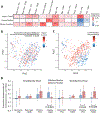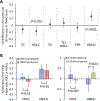Interplay between diet and gut microbiome, and circulating concentrations of trimethylamine N-oxide: findings from a longitudinal cohort of US men
- PMID: 33926968
- PMCID: PMC8553812
- DOI: 10.1136/gutjnl-2020-322473
Interplay between diet and gut microbiome, and circulating concentrations of trimethylamine N-oxide: findings from a longitudinal cohort of US men
Abstract
Objectives: Gut-produced trimethylamine N-oxide (TMAO) is postulated as a possible link between red meat intake and poor cardiometabolic health. We investigated whether gut microbiome could modify associations of dietary precursors with TMAO concentrations and cardiometabolic risk markers among free-living individuals.
Design: We collected up to two pairs of faecal samples (n=925) and two blood samples (n=473), 6 months apart, from 307 healthy men in the Men's Lifestyle Validation Study. Diet was assessed repeatedly using food-frequency questionnaires and diet records. We profiled faecal metagenome and metatranscriptome using shotgun sequencing and identified microbial taxonomic and functional features.
Results: TMAO concentrations were associated with the overall microbial compositions (permutational analysis of variance (PERMANOVA) test p=0.001). Multivariable taxa-wide association analysis identified 10 bacterial species whose abundance was significantly associated with plasma TMAO concentrations (false discovery rate <0.05). Higher habitual intake of red meat and choline was significantly associated with higher TMAO concentrations among participants who were microbial TMAO-producers (p<0.05), as characterised based on four abundant TMAO-predicting species, but not among other participants (for red meat, P-interaction=0.003; for choline, P-interaction=0.03). Among abundant TMAO-predicting species, Alistipes shahii significantly strengthened the positive association between red meat intake and HbA1c levels (P-interaction=0.01). Secondary analyses revealed that some functional features, including choline trimethylamine-lyase activating enzymes, were associated with TMAO concentrations.
Conclusion: We identified microbial taxa that were associated with TMAO concentrations and modified the associations of red meat intake with TMAO concentrations and cardiometabolic risk markers. Our data underscore the interplay between diet and gut microbiome in producing potentially bioactive metabolites that may modulate cardiometabolic health.
Keywords: cardiovascular disease; diet; epidemiology; intestinal microbiology; nutrition.
© Author(s) (or their employer(s)) 2022. No commercial re-use. See rights and permissions. Published by BMJ.
Conflict of interest statement
Competing interests: None declared.
Figures





References
Publication types
MeSH terms
Substances
Grants and funding
- K99 DK119412/DK/NIDDK NIH HHS/United States
- R00 DK122128/DK/NIDDK NIH HHS/United States
- R01 DK120870/DK/NIDDK NIH HHS/United States
- R01 DK119268/DK/NIDDK NIH HHS/United States
- U01 CA152904/CA/NCI NIH HHS/United States
- U01 CA167552/CA/NCI NIH HHS/United States
- P30 DK046200/DK/NIDDK NIH HHS/United States
- K99 DK122128/DK/NIDDK NIH HHS/United States
- R01 HL035464/HL/NHLBI NIH HHS/United States
- R01 HL060712/HL/NHLBI NIH HHS/United States
- P30 CA071789/CA/NCI NIH HHS/United States
- R00 DK119412/DK/NIDDK NIH HHS/United States
- R01 DK126698/DK/NIDDK NIH HHS/United States
- P30 DK043351/DK/NIDDK NIH HHS/United States
LinkOut - more resources
Full Text Sources
Other Literature Sources
